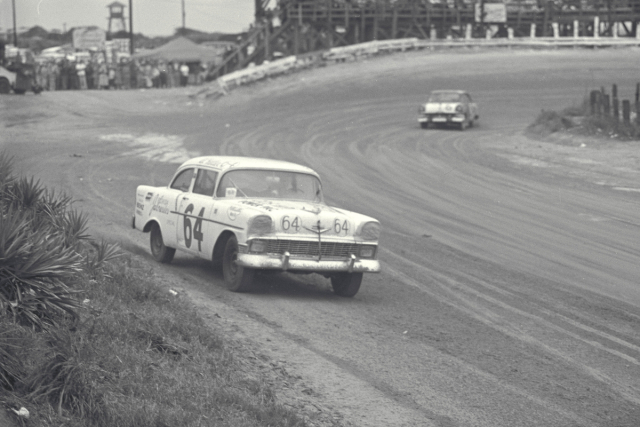Daytona 500 aside, NASCAR continues to play Russian Roulette with the very future of the sport of motor racing.
 Sunday, February 24, 2013 at 09:05PM
Sunday, February 24, 2013 at 09:05PM By Peter M. De Lorenzo
Detroit. Well, the Daytona 500 is in the history books and in a series of three tweets after the race I had the following to say:
It's Official: The Most Boring Daytona 500 ever run. Asleep at the Wheel has a name and it's NASCAR's new "Gen 6" racers on the big oval.
Memo to NASCAR apologists: Two columns of single-file racing isn't racing, it's a restrictor-plate processional. #headinsand
Last time I checked it's called the Daytona 500, not the "Let's run around for 200 laps and hope we don't wreck 500."
That said, there were three stories at Daytona. 1. Danica. 2. The fact that nobody can pass anybody in the "Gen 6" cars and, 3. The near catastrophic wreck at the end of the Nationwide race on Saturday afternoon (and the associated fallout) and hand-wringing.
Let me say right up front that Danica drove a smart, savvy race. She kept out of trouble and although I was hoping for a better finish for her she acquitted herself very well. So that was all good. She survived the relentless hype and came out the other side of it looking pretty damn impressive, so I'm happy for her. And Jimmie Johnson won the restrictor-plate processional at the end, which was good for him, crew chief Chad Knaus, Rick Hendrick and everyone at Hendrick Motorsports. (More coming up on the race in "The Line.")
But the racing with the much-touted "Gen 6" cars was simply nonexistent. I was chastised by a woman out in Twitterville (who shall remain nameless) who said: "Well, I guess you have to really love racing to appreciate today's race. I know I do." The implication being, of course, that I don't love racing or some such nonsense, which couldn't be further from the truth. I happen to love racing but let me be very clear about this for oh, probably the 87th time over the last five years on this website - what went on at Daytona wasn't racing. Because restrictor-plate "racing" isn't racing at all. Not one bit, in fact. It's a 200-lap crap shoot/processional that usually leads to one of two things: The inevitable "Big One," or two columns of cars going around the track in single-file "flying formation" with a "race" that ends with a whimper. Like Sunday's version of the Daytona 500. The "Gen 6" cars look much better, which is a gigantic improvement from the days of the dreaded CoT, but in terms of spicing up the actual racing they failed miserably.
NASCAR apologists say "give it time" and I say, really? The manufacturers knew what the racing would be like with these cars when they went testing with them six weeks ago. And guess what, nothing changed. So here's a question for all of you alleged NASCAR fans out there: Are you ready for a season that has NASCAR "developing" the car on your attendance dollar? If not, then you should probably be royally pissed-off and stay away - in droves - until they figure it out.
But this just in: NASCAR isn't likely to figure it out anytime soon. The wreck at the end of the Nationwide race was only the latest warning shot that NASCAR has endured, and they dodged another bullet again. This racing organization has been playing Russian Roulette with its fans and drivers since the famed Bobby Allison wreck at Talladega in 1987, when only sheer luck prevented a horrific loss of life on the scale of the famously tragic incident at the 24 Hours of Le Mans in 1955, when a factory Mercedes-Benz careened off of a slower car in front of the pits and went into a sea of spectators killing 83 people and injuring another 120+. The outrage over the carnage at Le Mans almost killed the sport of racing for good. The outrage was global, too, with some countries even banning motor racing for several years (France, Germany, Spain, Switzerland and others), while Mercedes-Benz officially withdrew from racing altogether for over 25 years. (And that all happened without the immediacy of the Internet.)
Cognizant of what happened on that tragic day at Le Mans, the leaders of NASCAR knew immediately that what had happened at Talladega was so close to a disaster of unspeakable proportion that it could never be repeated. They understood if a car ever went into the grandstands at a major stock car race it would be The End of NASCAR in every sense of the word.
So the era of restrictor-plate racing began.
And the idea was simple: slow the cars down by restricting the air flowing into the engine - reducing horsepower - and thus avoid any chance of an accident approaching the Allison crash at Talladega. And it worked, at least initially. But soon a sinister new side effect of the restrictor-plate era emerged, and that is that NASCAR "racing" on the "big" tracks was reduced to lethal packs of cars running inches apart with drivers having their feet pressed flat on the gas, lap after lap. And guess what? With no throttle control left for the drivers there was absolutely no room for error, but of course there were errors because drivers, after all, are human beings and massive wrecks ensued. And the idea of the "Big One" - and it being inevitable - became part of the NASCAR lexicon.
And as outrageous as that all sounds, the fact that NASCAR has failed repeatedly to do anything to stop is it is even more incredible to contemplate. Saturday's incident was only the latest bullet that NASCAR has dodged (and as I write this the seriousness of some of the spectator injuries have not been revealed, so I am in no way making light of this situation at all). But the fact remains that in this era of unprecedented communication - when breaking news simply blows up all channels of media instantaneously - can you imagine the collective media outrage - social and otherwise - if a car had gone into the grandstand on Saturday and mowed down hundreds of people?
I can assure you it would bring the sport of motor racing in this country and other parts of the world to a screeching halt. Insurance would simply become unavailable, and countries, states and local governments would raise their pitchforks en masse and go after the sport with blood in their eyes. And I'm not sure the sport could survive it. An incident of that severity wouldn't mean a brief nanosecond of hand-wringing and then we'd all be right back at it, oh no. It would take years for the sport to get back on its feet. Let me repeat that: years.
As I said, Saturday's incident at Daytona International Speedway was only the latest in a long line of incidents and episodes that NASCAR has emerged from relatively unscathed. But I have no doubt whatsoever that if NASCAR doesn't address this problem in a fundamental, life altering way, their luck will most definitely run out.
What can be done? Well, the initial outcry after Saturday's horrific incident focused on the fact that a redesign of the catch fencing is in order and that is, in fact, long overdue at every major racing venue in the world. IndyCar champion Dario Franchitti even tweeted about it Saturday afternoon in the aftermath of the wreck and that is completely understandable, because fellow IndyCar star Dan Wheldon lost his life after an impact with catch fencing at Las Vegas Motor Speedway.
But let's be realistic here. For example the SAFER barrier, which has been an incredible life saver at tracks across the country and around the world, took years to develop. Not months, but years of painstaking development so that they not only function properly and do what they're supposed to do but they do so in a relatively cost efficient manner, so that tracks can actually afford them. After all, if tracks can't deploy a safety development due to cost, what good is it?
To do a total rethink on a design for catch fencing is going to take years as well. Not to mention a huge financial investment. And for the record everybody has a blue-sky idea as to how to "fix" this situation but I can assure you it cannot and will not happen overnight. The world's racing organizations will have to come together to fund and develop a replacement for catch fencing, because it won't happen any other way. And that's going to take time and lots of it.
So in lieu of all this, what should NASCAR do? Well I can say without equivocation whatsoever that to not do something would be criminal, there is just no other way to put it. The consequences if NASCAR chooses to do nothing and to just keep going along like they've been doing because "we've always done it this way" would be dire, not only for NASCAR but for the entire sport of motor racing itself.
Again, what should NASCAR do? My suggestions over the last ten years have fallen on deaf ears down in Daytona Beach. After all, the prevailing attitude down there is who am I to criticize what they do and how they do things? But make no mistake, I speak for a lot of knowledgeable and experienced people involved who care about the future of this sport deeply. And business as usual - at least how NASCAR views it and conducts it - is simply inexcusable and unacceptable.
A solution? I've suggested this for years, but the powers that be in NASCAR must tap into the participating manufacturers' technological know how and go to smaller displacement engines for the bigger tracks as soon as possible. And I'm not talking a small reduction in displacement either. The manufacturers participating in NASCAR have a brace of small-displacement 4- and 6-cylinder engines bristling with advanced technology that would make for a very interesting solution and provide even more of a connection to their production car counterparts. And it would establish a new level of competitiveness and technology that would only serve to benefit NASCAR in the end.
I'm guessing the outcry against smaller displacement engines would be deafening in some circles, but to that I would say this: I would rather conduct an intense exploration of that technological solution than live through another harrowing day like what happened last Saturday afternoon in Daytona.
Here's hoping that the participating manufacturers put pressure on NASCAR to make the necessary changes.
And here's hoping that NASCAR steps up to its responsibility and finally does the right thing.
Because the alternative, meaning NASCAR conducting business as usual, is just too depressing to contemplate.
Publisher's Note: As part of our continuing series celebrating the "Glory Days" of racing, we're proud to present another noteworthy image from the Ford Racing Archives. - PMD
 (Courtesy of the Ford Racing Archives and Wieck Media)
(Courtesy of the Ford Racing Archives and Wieck Media)
Daytona Beach, Florida, February 26, 1956. Al Keller in his No. 64 Chevrolet at speed in the NASCAR Grand National race on the 4.100-mile Beach and Road Course during Daytona Beach Speed Week. Tim Flock (No. 300A Karl Kiekhaefer Chrysler) would win the 159.9-mile race with Billy Meyers (No. 14W Bill Stroppe Mercury) and Ralph Moody (No. 12 Pete DePaolo Southeastern Dealers Ford) finishing 2nd and 3rd. Keller would finish 6th that day.
Publisher's Note: Like these Ford racing photos? Check out www.fordimages.com. Be forewarned, however, because you won't be able to go there and not order something. - PMD






